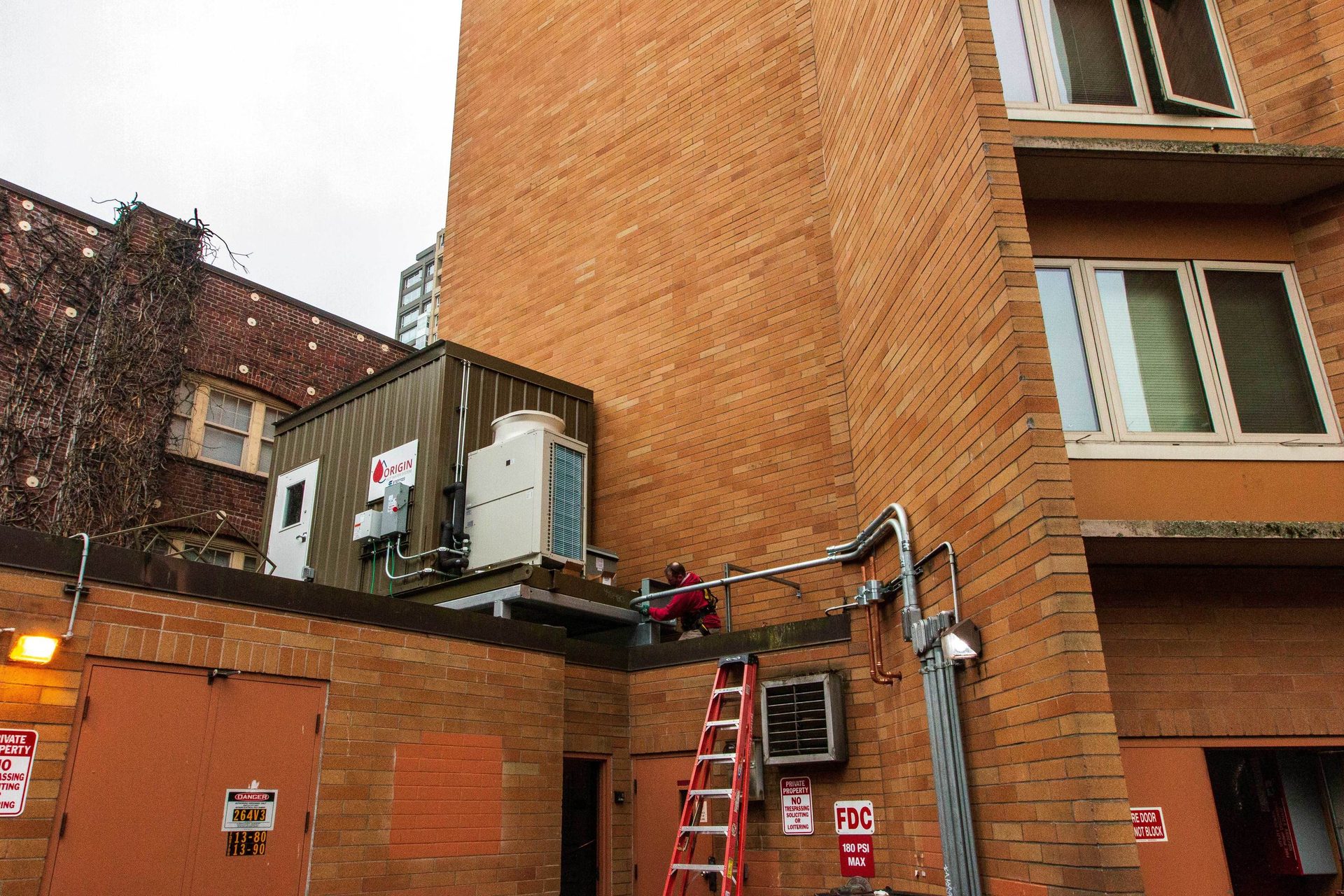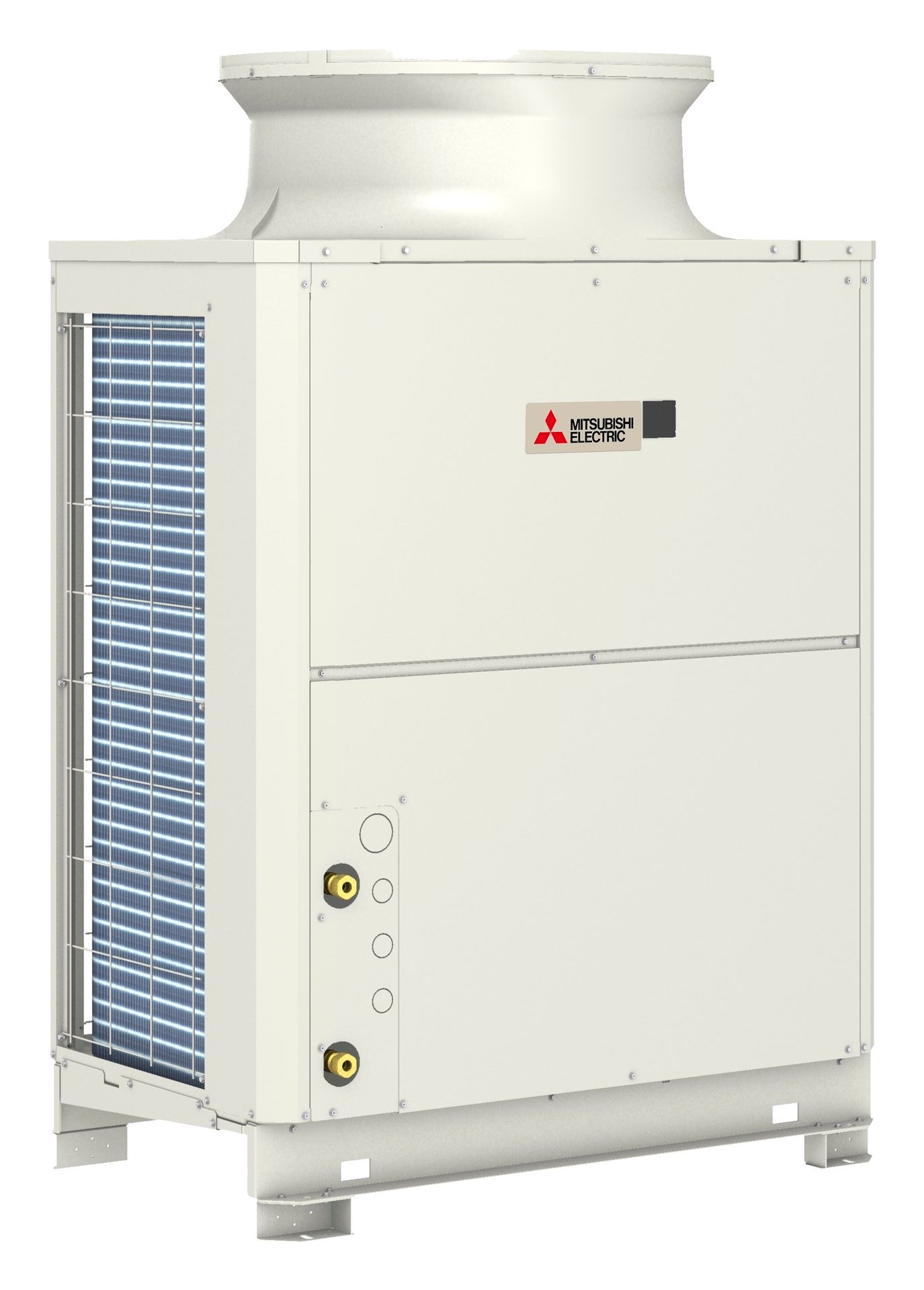




FEATURE
SCROLL
Preparing for the Future with All-Electric VRF Technology
Variable refrigerant flow (VRF) systems offer significant benefits for engineers and the commercial building industry.
VRF technology divides a building into zones with individual set points customized for occupant usage, typical solar loads, energy efficiency, and comfort. With no need for fossil fuels, an all-electric VRF heat pump or heat-recovery system provides energy-efficient heating and cooling by cycling refrigerant between an outdoor unit and each zone’s ductless or ducted indoor unit. Up to 50 indoor units can connect to a single outdoor unit. By selecting VRF zoning systems and heat pump water heaters, engineers can help developers and owners future-proof buildings for compliance, tenant expectations, and market value.

FIGURE 1. The Credit Human Federal Credit Union headquarters in San Antonio utilizes CITY MULTI® water-source VRF systems from Mitsubishi Electric Trane HVAC US (METUS), which are designed to provide reliable, energy-efficient heating and cooling for the open and collaborative 200,000-square-foot space.
Images courtesy of Mitsubishi Electric Trane HVAC US
Electrify Everything: The Time Is Now
Strategic electrification is the movement to reduce energy use and society’s dependence on fossil fuels by switching to energy-efficient, all-electric technologies. Energy-efficient mechanical systems draw less energy from electricity grids transitioning from fossil fuels. As grids generate more electricity from renewable hydroelectric, wind, and solar power sources, the grid becomes cleaner and stronger — all-electric systems that minimize surplus energy use, such as space and water conditioning technologies, only further strengthen the grid.
Energy efficiency and superior comfort experiences have made VRF systems one of the fastest growing segments of the commercial HVAC industry, but sustainability through electrification is increasing nationwide demand for the technology. Building owners and developers are navigating an evolving real estate market and regulatory environment where sustainability significantly impacts their properties' values, operating costs, and marketability. Strategic electrification is happening now, driven by a mix of public and private entities on the local, state, and national levels, and proceeding along voluntary and mandatory paths, including through legislation like the Inflation Reduction Act.
Utilities, states, cities, agencies, and nonprofits have published studies and reports on how strategic electrification is the best way to achieve aggressive carbon emission reduction goals. An example is New Jersey’s 2019 Energy Master Plan: Pathway to 2050. The report contains an analysis of decarbonization pathways performed by Evolved Energy Research and RMI for the New Jersey Board of Public Utilities. Per the analysis, fully electrifying vehicles and building systems is the most sensible decarbonization pathway for New Jersey. Electric appliances and vehicles save money by using “roughly one-third the energy of gasoline vehicles or natural gas-fired water heaters and furnaces.” Electrified buildings give the state more options for energy generation and can lead to new quality jobs in the electricity and building industries, including HVAC and plumbing.
New Jersey’s report recommends wider adoption of heat pumps in residential and commercial buildings and suggests the state provide incentives for installing all-electric building systems. This recommendation is consistent with other reports on decarbonization and electrification, including The Action Plan to Accelerate Strategic Electrification in the Northeast and the Variable Refrigerant Flow (VRF) Market Strategies Report, published by Northeast Energy Efficiency Partnerships (NEEP), one of six regional energy efficiency organizations (REEOs) funded in part by the U.S. Department of Energy.
Guidehouse Research suggests energy efficiency spending in North America will grow to nearly $11 billion per year over the next decade. Public and private initiatives toward decarbonization coupled with the cost of energy are driving more stringent building codes and legislation. This includes rebates and financial incentives to encourage more sustainable buildings and the adoption of high-performance heat pumps and VRF systems. Along with federal standards and programs, like Energy Star, tax credits and utility rebates will continue accelerating the adoption of energy-efficient alternates to fossil-burning systems.

FIGURE 2. The Heat2O system can be seen at the Bayview Tower in Seattle.
Solving Electrification Challenges with VRF Technology
VRF systems are uniquely positioned to help building owners meet CO2 reduction goals and lower energy use and costs. They’re designed for extended life cycles providing sustainable performance well into the future.
Across the U.S., a decline in coal-fired electricity reduced CO2 emissions by 2.1% in 2019. The last large coal-fired power plant in New England closed in May of 2017, and the last of New York’s coal plants closed in 2020. Renewable energy is now cost competitive with fossil-fuel-based generation for utility companies.
The energy efficiency and intelligence of VRF systems will help utilities manage the challenges of peak loads, utility-scale storage, and variable generation from wind and solar power. As strategic electrification expands, this will be increasingly important. Depending upon electrification adoption, the annual nationwide demand for electricity may increase by up to 3,700 terawatt hours or 85% by 2050.
Energy efficiency is a prerequisite for decarbonization. In regions with carbon-intensive power grids, using more efficient systems and appliances helps reduce energy consumption as a good first step toward lowering carbon footprints. Variable-capacity VRF heating and cooling systems are up to 40% more energy efficient than conventional, fixed-capacity HVAC equipment. Most of these savings occur during partial-load conditions, as VRF systems use inverter-driven compressors to adjust capacity and energy consumption to precisely match each zone’s load.

FIGURE 3. Refrigerant water flow in the Heat2O Heat Pump Water Heater from Mitsubishi Electric Trane HVAC US.
VRF systems regularly achieve coefficients of performance (COPs) of 3 and higher, meaning they can deliver much more heat than the power they consume in watts. Additionally, VRF systems require less ductwork than forced-air systems, further reducing the energy consumed by large fan motors.
Commercial heat pump water heaters using similar inverter-driven compressor technology are now available to provide high-volume domestic hot water (DHW) for commercial buildings. DHW accounts for roughly 25% of annual energy usage in multifamily buildings, hotels, hospitals, senior living facilities, and other commercial spaces. This energy expenditure is costly for building owners and has a significant environmental impact due to greenhouse gas emissions. As a solution, Mitsubishi Electric recently introduced the all-electric, cold-climate Heat2O Hot Water Heat Pump to significantly reduce the environmental impact of DHW through energy-efficient operation and use of CO2 refrigerant.
CO2, a natural and environmentally friendly refrigerant with a global warming potential (GWP) of 1 and an ozone depletion potential (ODP) of zero, helps commercial facilities qualify for rigorous sustainability certifications, such as passive house status. Using Heat2O reduces on-site carbon emissions in the production of domestic hot water.

FIGURE 4: A Heat2O Heat Pump Water Heater QAHV.
Decarbonized Water Heating
The Heat2O system achieves highly efficient heat exchange using a patented twisted spiral gas cooler, where three refrigerant lines are wrapped around a twisted water pipe. The CO2 refrigerant flows in the opposite direction of the water. Running the refrigerant lines along the pipe’s grooves increases the heat-conductive area, while the spiral helps create a vortex in the pipe, accelerating the turbulence effect of water and reducing pressure loss in the heat exchanger. Transferring thermal energy from outdoor air to potable water by cycling refrigerant, natural CO2 enables the system to supply hot water up to 176°F, even when outside temperatures are as low as minus 13°.
The inverter-driven scroll compressor in the heat pump further increases Heat2O’s energy efficiency by enabling the system to modulate refrigerant flow and heating capacity to match loads. Heat2O can provide over four times more energy as heat than the system consumes in electricity.
With a COP of up to 4.52, Heat2O offers energy savings of 60%-70% for building owners and tenants compared to electric-resistance water heaters. If employed at scale in the U.S. alone, the environmental impact could be significant. Energy savings combined with incentives from utilities can ultimately offset first costs.
Heat2O is an engineered solution designed to ensure installation quality and optimal performance of the heat pump. Components include a heat pump water heater; hot water storage tanks; swing tanks, secondary heat exchangers; and variable-speed, secondary circuit pumps.
All-electric DHW is already in demand for commercial buildings looking to meet aggressive sustainability and energy-cost measures. Preliminary data from an installation at the Bayview Tower, a Seattle Housing Authority multifamily dwelling, indicates Heat2O will save the housing authority more than 136,875kWh/year (a 40% decrease). This equates to about $15,000 in operational savings annually (using $0.11/kWh electrical rate). Previously, the building relied on an aging electric boiler system to produce DHW for 100 one-bedroom apartments on 13 stories.
Hotel Marcel, a $50 million renovation of the historic Pirelli building in New Haven, Connecticut, is one of the first net-zero hotels in the U.S. A Heat2O system is installed to achieve the project’s sustainability goals, including LEED Platinum certification and being 60% more energy efficient than code requirements.
Heat2O is available in select markets, including New York, Massachusetts, Washington, Oregon, and Northern California. A nationwide rollout is anticipated for 2023.
